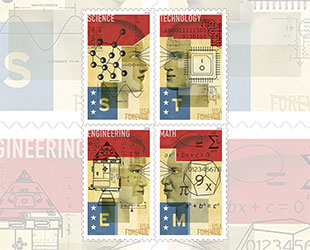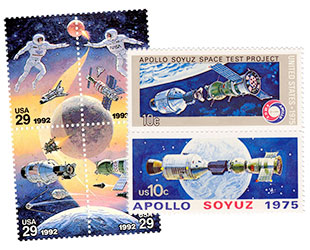April 7, 2018 — NASA's Apollo spacecraft symbolizes the "E" in "STEM" on a set of four new U.S. postage stamps.
The U.S. Postal Service (USPS) on Friday (April 6) issued its new "STEM Education" Forever stamps, celebrating the role of science, technology, engineering and math (STEM) education in keeping the U.S. a global leader in innovation. Each of the four STEM Education stamps feature a collage of faces, symbols, drawings and numbers to represent the complexity and interconnectedness of the disciplines.
"We wanted to celebrate the centrality of human creativity in all of the STEM disciplines," William Gicker, the creative director and manager of stamp development for the USPS, told collectSPACE. "Since the areas of STEM overlap each other, the stamps themselves needed to not only visually stand on their own but also connect and overlap with each other."
"Collage was the illustration technique used to portray four representative people thinking about their specific area of interest in regards to STEM," Gicker described. "Another element to the overall design theme was to include several different visual items in each stamp to suggest the breadth of each discipline."

The U.S. Postal Service's STEM Education stamps feature collages composed by illustrator and graphic artist David Plunkert. (USPS) |
To that end, the "Science" stamp includes a representation of molecules, the "Technology" stamp features a diagram of a microchip and the stamp for "Math" has a polyhedron. The "Engineering" stamp features the spacecraft that flew the first humans to the moon 50 years ago this December.
"Though we were aware of the anniversary, it was not why we selected it. When we were designing these stamps we did not know in which year they would be issued," Gicker said. "As it turns out it was a happy coincidence!"
The USPS worked with artist David Plunkert to create the "STEM Education" stamps. Known for his theater posters and editorial illustrations, Plunkert's artwork has appeared on the cover of The New Yorker and on the pages of other major magazines and newspapers. His other clients have included MTV, Nike and Capitol Records.
In designing the stamp for "Engineering," Plunkert and art director Antonio Alcalá looked at many different examples of the discipline. They chose the Apollo command module and service modules as an example that "carries positive associations and is recognizable to the public," explained Gicker.
Along with the lunar module used to land astronauts on the moon, the command and service modules (CSM) formed the complete Apollo spacecraft. First launched with a crew on the Apollo 7 mission in October 1968, the Apollo CSM flew astronauts Frank Borman, Jim Lovell and Bill Anders on humanity's first journey to the moon two months later.
The Apollo CSM flew with astronauts on 15 missions into space, including nine flights to the moon, three missions to the first United States space station Skylab and on the first joint flight with the Russians, the Apollo-Soyuz Test Project (ASTP), in 1975.

U.S. stamps released in 1975 and 1992 were the first to include the Apollo command and service modules in their artwork. (USPS) |
Plunkert referenced NASA diagrams to ensure an accurate depiction of the spacecraft on the stamp, while also taking into account the size of the canvas and his artistic vision.
"The artist [Plunkert] combined the spacecraft with other elements to give the viewer a sense of the complexity of the engineering disciplines and some surface details were edited due to the scale the image would run and to allow other background elements to show through," Gicker said. "We did work with several experts, including engineers, to review the design and to help us balance the need for accuracy and artistic license required to make the art work at stamp size."
The STEM Education "Engineering" stamp marks the third time that the Apollo CSM has appeared on USPS issues. Previously, the spacecraft was part of the design of stamps commemorating the 1975 ASTP mission and was used to recognize U.S. and Russian "Space Accomplishments" on another four-stamp block in 1992.
"We do take into consideration past stamp representations when deciding what to include on new stamps. In this case we were using the Apollo command and service module to represent what engineers can achieve," said Gicker.
